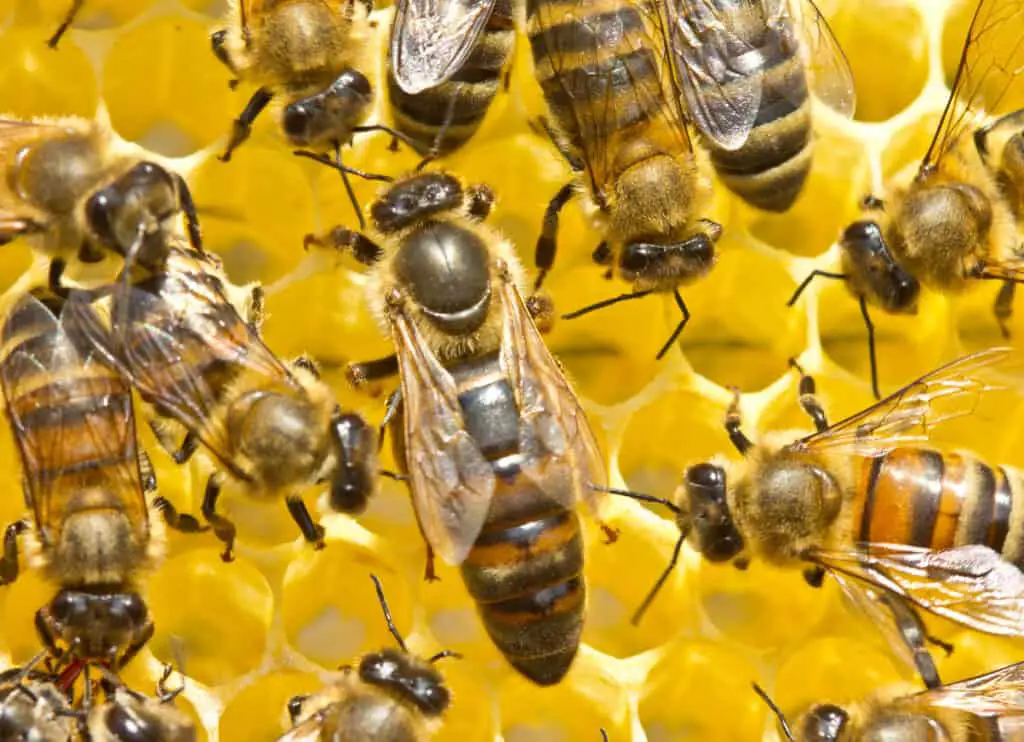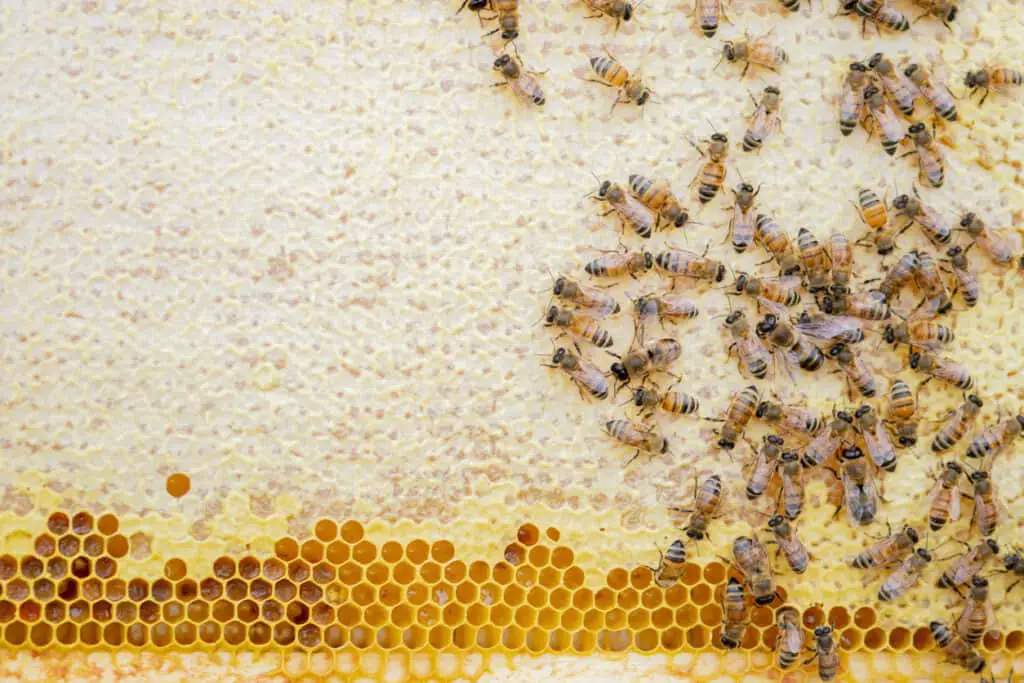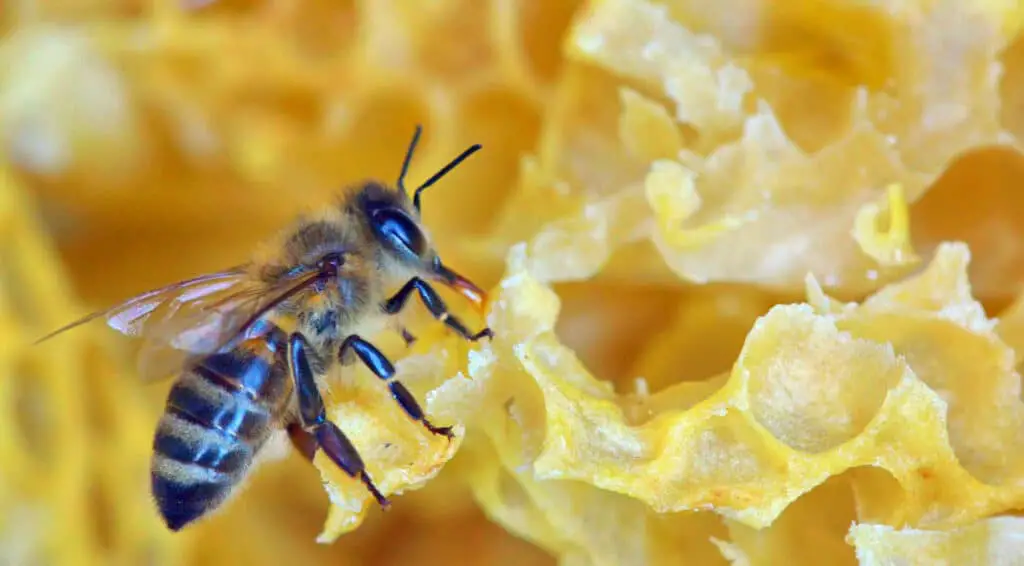If you’ve ever had the unfortunate scenario where you were stung by a bee, you would know firsthand that it’s not a pleasant experience. You might wonder what type of bee stung you, blaming everyone from the male drones, the worker bees, and even the queen bee, depending on the pain level. Made me wonder if queen bees sting humans as worker bees do?
Queen bees sting. When a virgin queen is born, she will attempt to kill all other queen bees using her deadly barbless stinger, but when mated, the queen uses the stinger as a modified ovipositor to help her lay and position her eggs. Queen bees sting the occasional beekeeper, but that’s about it.

Newborn queen bees come out of their queen cells, stingers blazing, stinging any bee that resembles a queen, unborn or alive. The queen bee that survives the royal death match becomes the hive’s queen and, after being mated, uses her stinger for laying eggs. A typical queen bee won’t use her stinger to sting for the rest of her days.
Do Queen Bees Sting?

Queen bees sting. Upon leaving her brood cell, a virgin queen bee will attempt to kill all living queen bees, even the developing queen pupae inside their queen cells. If two queens hatch simultaneously, you can bet your bottom dollar that a fight to the death will ensue.
There can only be one queen bee! Queen bees don’t tolerate other queen bees in the colony. When one queen remains, she will mate and start laying eggs, becoming the mother of most bees in the hive.
The only time she could be forced to attack another queen bee in her lifetime is when superseding takes place; that’s when an old or sick queen needs to be replaced by a functioning queen.
Do Queen Bees Sting Humans?
You won’t often hear a beekeeper tell a story of “that time the queen bee stung me.” Queen bees stinging humans, for whatever reason, doesn’t seem to happen as often as a worker bee stinging a person.
According to beekeepers at Wildflower Meadows, who hold, mark, and cage “tens of thousands of queen bees each year,” there has yet to be one report of a queen bee sting involving one of their keepers. They claim their queen bees maintain a “peaceful and graceful quality” while enduring the handling process.
Does A Queen Bee Sting Contain Venom?

Honey bee queens possess venom glands much as worker bees do. Although they have certain characteristics, these glands share similar anatomy to worker bees, with the size the primary variable.
A queen bee may store up to five times as much venom as a worker, and its venom reservoir is three times bigger. Queens also have longer excretory ducts and forked branches. Just before they leave their queen cell, queens begin to produce venom.
Once they emerge, their venom gland is active and prepared to be used to exterminate other virgin queens. The queen’s primary job in a bee colony is to lay eggs after mating. The protein content of her venom gradually declines over time since it is no longer required, dropping by 90% after her first week.
Is A Queen Bee Sting Painful?
As mentioned before, after a queen bee has mated, she hardly stings at all. Humans and other animals are relatively safe from queen bee attacks as the role of hive protector doesn’t rest with her. The online consensus is that a queen bee’s sting is not as painful as being stung by a worker bee.
The reason is that, unlike a worker bee sting which leaves a barbed stinger in your skin with a venom sack pumping in extra venom for good measure, a queen bee’s stinger goes in and out of the skin, causing some discomfort, yet nowhere close to the pain administered by a worker bee sting.
Can A Queen Bee Sting Kill You?
If you’re indeed allergic to bee stings, you could potentially be in danger when a queen bee decides to go against her natural nature and starts stinging everything in sight. Should you be stung by a virgin queen bee, you are in danger of a deadly allergic reaction, as young queen bees’ venom is 15 times more toxic than an older queen.
A stinging queen bee can technically sting you more than a worker bee, increasing the probability of an allergic reaction. Luckily, like all mothers, they have much more important things to do than stinging people all day.
Do Mated Queen Bees Sting?
Mated bees don’t need to murder other competitors for the crown, as virgin queen bees need to do. It’s because queen raising is typically avoided when a healthy laying queen is actively controlling the hive with her pheromones and delivering up to 1,500 eggs per day.
The laying queen will use her stinger to kill the “new queen” brood within if the normal inhibitions that stop a colony from generating a new queen are broken and queen cells are raised inappropriately.
When this scenario plays out in a hive, it provides the laying queen plenty of time to do so because it takes a new queen roughly 16 days to emerge. Mated queens stay in the laying chamber and stop stinging after mating.
The mated queen will often leave the hive just before the virgin queens emerge if a colony raises new queens in anticipation of a swarm. By doing this, any potential for confrontation is eliminated.
Is A Queen Bee Stinger The Same As That Of A Worker Bee?
The stinger of a queen bee differs from a worker bee’s not just in appearance but also function. A queen bee stinger is not barbed like the stinger of a worker bee. The smooth stinger of the queen bee can be used to sting multiple times without it leading to the queen’s death.
Worker bee stingers are “barbed,” which means they have a small hook on the ends. That barb keeps the stinger in the skin and dismembers the bee as they stab their chosen victim and take off. The bee will shortly pass away, but the remaining stinger can still produce venom.
The victim of a worker bee sting is left with the little stinger still embedded in their skin. There is a little yellow sac above the stinger. Even after the stinger has separated from the bee, the venom will still be pumped into the victim from the sac.
Worker honey bees’ stingers are primarily used to protect the hive against intruders. Worker bees are like the old Japanese “kamikaze” fighters. They literally give their lives willingly for their colonies to survive.
What Is The Main Function Of A Queen Bee’s Stinger?
You would think that the main function of a queen bee’s stinger is to kill rival queens, ensuring the queen with the deadliest stinger becomes the one and only queen of the hive.
But this is only partially true. Although the stinger plays a decisive role in making it to the top spot of the queen of the hive, a queen bee’s stinger’s main function is to help the queen lay and position eggs. A queen bee’s stinger is, in fact, a modified ovipositor.
The modified ovipositor is a highly functional piece of equipment that allows the queen to carefully place eggs inside the brood cells before the worker bees cap of the cells.
Do Worker Bees Sting?
Worker bees, the bees that make sure that the hive is a fully functioning honey unit, can and will use their stingers when they deem necessary. Contrary to popular belief, not all bees sting or can sting.
When it comes to honey bees, the main stingers are the worker bees, as the male drones cannot sting as they don’t have stingers.
When Will A Worker Bee Sting?
Getting stung by a bee isn’t a fun experience, whether you’re allergic to these stings or not. People tend to think that bees are evil insects who get pleasure out of the act of hurting innocent people. Turns out our actions before getting stung aren’t as innocent as we would like to believe.
Worker Bees Sting When Their Hive Is Threatened
Bees are programmed to perceive huge mammals as threats when approaching their hive. This programming is because they are accustomed to having bears, badgers, skunks, and other creatures steal their honey.
Bees may perceive you as a threat if you approach their hive too closely. The workers will jump into action and sting you to protect their hive. The same goes for honey bees from a different swarm or any other type of bee, for that matter.
Interestingly, some honey bees resort to becoming robber bees, where they infiltrate a healthy hive to steal some honey. Worker bees assigned as guard bees are tasked to ensure that all bees entering the colony are part of their family.
They perform this task by way of pheromone confirmation. Each queen bee has a unique pheromone that all of the bees in a hive carry. If a guard bee detects that a bee doesn’t carry the queen’s pheromone, it will release an alarm pheromone to inform the hive of the intruder(s) and attract other worker bees to come help with the removal of the intruder bee(s).
Removing an intruder bee typically involves the worker bees forming a ball around the invader, pushing and stinging the subject to the hive’s entrance.
Working Bees Sting When Intimidated
Intimidating actions, or aggressive behavior, will get you stung. When you decide to swat at a worker bee or perform a lot of abrupt motions, the bee can feel intimidated.
The more drastic your movement, the more the worker bee perceives you as a threat to themselves, their hive, and their brothers and sisters. For your intimidating behavior, you get a painful sting as a reward.
What To Do When A Bee Stings You
A bee sting is typically unexpected if you’re not a beekeeper. Bee stings of any kind are not a pleasant experience, and here’s what you need to do when it happens to you. The American Academy of Dermatology Association suggests you do the following:
Step 1: Get Away From The Bees
When you are stung by a bee, there’s probably a reason unknown to you for the scenario. Maybe you inadvertently moved too close to the bee’s nest. The first thing you need to do is to calmly walk away from the area of attack, ensuring that no additional attacks are coming.
Step 2: Remove The Bee’s Stinger
The chances are very high are that you have been stung by a worker bee, which means the stinger will be stuck in your skin. Remove the stinger by taking a piece of gauze or your fingernail to scrape over it until it dislodges from your skin. Don’t resort to using a tweezer, as you can inadvertently squeeze more venom into your body.
Step 3: Wash The Sting Area
After removing the stinger, wash the sting area with soap and water.
Step 4: Apply Ice To Reduce Swelling
Apply a cold pack or some ice to the affected area to reduce the swelling that often occurs when stung by a bee. Should the swelling move to other parts of your body, head on straight to an emergency center as this could indicate that you have an allergic reaction. Additional signs of an allergic reaction include:
- Nausea
- Hives
- Dizziness
- Difficulty Breathing
Step 5: Take Painkillers
Getting stung by a bee is typically a painful experience for many. Using painkillers like over-the-counter ibuprofen and acetaminophen can help reduce pain levels. Ask a pharmacist if you’re not sure what to take.
Step 6: Monitor The Victim Of A Bee Sting
Keeping a close eye on somebody who has been stung by a bee is a smart and considerate thing to do. Serious symptoms can develop after a while, and if the person has been stung multiple times, it’s even more vital to look for signs of an allergic reaction.
Conclusion
A queen bee can sting, but you have a better chance of winning the lottery than being stung by the queen bee, except if you’re a beekeeper. Then the odds are 50/50. Queen bees sting their way to the throne at the beginning of their life, and when the hive prematurely starts preparing ‘new’ queens when the time is not right. For the rest of their lives, they use it to lay eggs.
References
https://www.sciencefocus.com/nature/does-a-queen-bee-ever-sting/
https://www.jcehrlich.com/bees/bee-stings/
https://beekeepinglikeagirl.com/6-things-you-didnt-know-about-queen-bees/
https://www.aad.org/public/everyday-care/injured-skin/bites/treat-bee-sting
https://wildflowermeadows.com/2020/01/can-queen-bees-sting/
https://en.wikipedia.org/wiki/Queen_bee
https://backyardbeekeeping.iamcountryside.com/health-pests/emergency-swarm-supercedure-cells/

